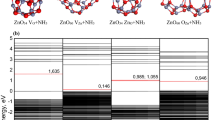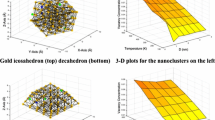Abstract
First principle investigations of native point defects in (ZnO)n nanoclusters (n = 34, 60) based on density-functional theory within the general gradient approximation plus Hubbard U, for different types of isomers, were performed. For each type of defect, an optimization (relaxation) of structures geometry was performed and the basic properties of the band structure were investigated. The values for formation energy, HOMO–LUMO gap, as well as the partial density of states for each cluster were investigated to establish the influence of the defects on the electronic properties of the (ZnO)n nanoclusters. It was determined that the most favorable defects of the clusters structure were Zn and O vacancies.






Similar content being viewed by others
References
Andzelm J, King-Smith D, Fitzgerald G (2001) Geometry optimization of solids using delocalized internal coordinates. Chem Phys Lett 335:321
Bobitski YAV, Bovhyra RV, Popovych DI, Savka SS, Serednytski AS, Shevchuk VN, Venhryn YuI (2017) The influence of surface doping on adsorption ability of nanopowder metal oxides for gas sensors. J Nano-Electron Phys 9(5):05008
Bovgyra OV, Bovgyra RV, Kovalenko MV, Popovych DI, Serednytski AS (2013) The density functional theory study of structural and electronical properties of ZnO clusters. J Nano-Electron Phys 5(1):01027
Bovgyra OV, Bovgyra RV, Popovych DI, Serednytski AS (2015) The density functional theory study of electronical properties of (ZnO)12 clusters during gas adsorbtion. J Nano-Electron Phys 7(4):04090
Bovhyra RV, Kovalenko MV, Franiv AV, Bovgyra OV (2011) Ab initio study of ZnO nanotubes sensing properties. Uzhhorod Univ Sci Her Ser Phys 29:47
Bovhyra RV, Zhyrovetsky VM, Popovych DI, Savka SS, Serednytsky AS (2016) Development and creating of gas-sensor system based on low dimensional metal oxides. Sci Innov. https://doi.org/10.15407/scin12.06.059
Bovhyra et al (2017) Ab initio study of structural and electronic properties of (ZnO)n “Magical” nanoclusters n = (34, 60). Nanoscale Res Lett. https://doi.org/10.1186/s11671-016-1238-7
Brown ME (1957) ZnO—rediscovered, 1st edn. New Jersey Zinc Company, New York
Erhart P, Albe K (2006) First-principles study of migration mechanisms and diffusion of oxygen in zinc oxide. Phys Rev B 70:115207
Erhart P, Klein A, Albe K (2005) First-principles study of the structure and stability of oxygen defects in zinc oxide. Phys Rev B 72:085213
Fan Q, Yang J, You Y, Zhang J, Cao J (2015) Electronic structure and optical properties of Al-doped ZnO from hybrid functional calculations. Chem Eng Trans 46:985–990
Gafiychuk VV, Ostafiychuk BK, Popovych DI, Popovych ID, Serednytski AS (2011) ZnO nanoparticles produced by reactive laser ablation. Appl Surf Sci 257(20):8396–8401
Hadipour NL, Ahmadi Peyghan A, Soleymanabadi H (2015) Theoretical study on the Al-doped ZnO nanoclusters for CO chemical sensors. J Phys Chem 119:6398–6404
Haffad S, Cicero G, Samah M (2011) Structural and electronic properties of ZnO nanowires: a theoretical study. Energy Procedia. https://doi.org/10.1080/10584587.2014.905086
Heo YW, Varadarajan V, Kaufman M, Kim K, Norton DP, Ren R, Fleming PH (2002) Site-specific growth of ZnO nanorods using catalysis-driven molecular-beam epitaxy. Appl Phys Lett 81:3046
Huang GY, Wang CY, Wang JT (2012) Detailed check of the LDA + U and GGA + U corrected method for defect calculations in wurtzite ZnO. Comput Phys Commun. https://doi.org/10.1016/j.cpc.2012.03.017
Jagadish C, Pearton S (2006) Zinc oxide bulk, thin films and nanostructures: processing properties and applications. Elsevier, Amsterdam
Kovalyuk B, Kovalyuk B, Mocharskyi V, Nikiforov Y, Onisimchuk V, Popovych D, Serednytski A, Zhyrovetsky V (2013) Modification of structure and luminescence of ZnO nanopowder by the laser shock-wave treatment. Physica Status Solidi (c) 10(10):1288–1291
Lannoo M, Bourgoin J (1981) Point defects in semiconductors I: theoretical aspects. Springer, Berlin
Lany S, Zunger A (2007) Dopability, intrinsic conductivity, and nonstoichiometry of transparent conducting oxides. Phys Rev Lett 98:045501
Lee E-C, Kim Y-S, Jin Y-G, Chang KJ (2001) Compensation mechanism for N acceptors in ZnO. Phys Rev B 64:085120
Lu JG, Chang P, Fan Z (2006) Quasi-one-dimensional metal oxide materials—synthesis, properties and applications. Mater Sci Eng R Rep 52:49–91
McCluskey MD (2015) Point defects in ZnO. Semicond Semmetals. https://doi.org/10.1080/10584587.2014.905086
Monastyrskii LS, Boyko YV, Sokolovskii BS, Potashnyk VYA (2016) Electronic structure of silicon nanowires matrix from Ab initio calculations. Nanoscale Res Lett. https://doi.org/10.1186/s11671-016-1238-7
Monkhorst HJ, Pack JD (1976) Special points for Brillouin-zone integrations. Phys Rev B 13:5188
Oba F, Choi M, Togo A, Tanaka I (2011) Point defects in ZnO: an approach from first principles. Sci Technol Adv Mater 12(2011):034302. https://doi.org/10.1088/1468-6996/12/3/034302
Onodera A (2002) Novel ferroelectricity in II–VI semiconductor ZnO. Ferroelectrics 267:131–137
Ӧzgür Ü, Alivov YI, Liu C, Teke A, Reshchikov MA, Doğan S, Avrutin V, Cho SJ, Morkoc H (2005) A comprehensive review of ZnO materials and devices. J Appl Phys 98:041301
Paudel TR, Lambrecht WRL (2008) First-principles calculation of the O vacancy in ZnO: a self-consistent gap-corrected approach. Phys Rev B 77:205202
Perdew JP, Burke K, Ernzerhof M (1996) Generalized gradient approximation made simple. Phys Rev Lett 77:3865
Peyghan AA, Noei M (2013) Electronic response of nano-sized cages of ZnO and MgO to presence of nitric oxide. Chin J Chem Phys 26(2):231–236
Peyghan AA, Noei M (2014) The alkali and alkaline earth metal doped ZnO nanotubes: DFT studies. Phys B 432:105–110
Peyghan AA, Laeen SP, Aslanzadeh SA, Moradi M (2014) Hydrogen peroxide reduction in the oxygen vacancies of ZnO nanotubes. Thin Solid Films 556:566–570
Salimi H, Peyghan AA, Noei M (2015) Adsorption of formic acid and formate anion on ZnO nanocage: a DFT study. J Clust Sci 26:609. https://doi.org/10.1007/s10876-014-0815-0
Savka SS, Popovych DI, Serednytski AS (2017) Molecular dynamics simulations of the formation processes of zinc oxide nanoclusters in oxygen environment. In: Fesenko O, Yatsenko L (eds) Nanophysics, nanomaterials, interface studies, and applications, NANO 2016. Springer proceedings in physics, vol 195. Springer, Cham
Van de Walle CG (2000) Hydrogen as a cause of doping in Zinc oxide. Phys Rev Lett 85:1012
Wang B, Nagase S, Zhao J, Wang G (2007) The stability and electronic structure of single-walled ZnO nanotubes by density functional theory. Nanotechnology. https://doi.org/10.1088/0957-4484/18/34/345706
Yaakob MK, Hussin NH, Taib MFM, Kudin TIT, Hassan OH, Ali AMM, Yahya MZA (2014) First principles LDA + U calculations for ZnO Materials. Integr Ferroelectr. https://doi.org/10.1080/10584587.2014.905086
Zhyrovetsky et al (2017) Nanopowder metal oxide for photoluminescent gas sensing. Nanoscale Res Lett. https://doi.org/10.1186/s11671-017-1891-5
Author information
Authors and Affiliations
Contributions
All the authors took part in solving the problem under study. They read and approved the final manuscript.
Corresponding author
Ethics declarations
Conflict of interest
On behalf of all authors, the corresponding author states that there is no conflict of interest.
Additional information
Publisher’s Note
Springer Nature remains neutral with regard to jurisdictional claims in published maps and institutional affiliations.
Electronic supplementary material
Below is the link to the electronic supplementary material.
Rights and permissions
About this article
Cite this article
Bovhyra, R., Popovych, D., Bovgyra, O. et al. First principle study of native point defects in (ZnO)n nanoclusters (n = 34, 60). Appl Nanosci 9, 1067–1074 (2019). https://doi.org/10.1007/s13204-018-0706-z
Received:
Accepted:
Published:
Issue Date:
DOI: https://doi.org/10.1007/s13204-018-0706-z




